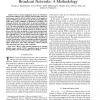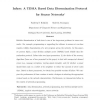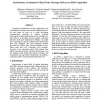INFOCOM
2011
IEEE
13 years 8 months ago
2011
IEEE
—The multiple-access framework of ZigZag decoding [1] is a useful technique for combating interference via multiple repeated transmissions, and is known to be compatible with dis...
TSMC
2002
14 years 4 months ago
2002
Due to its fixed assignment nature, the well-known time division multiple access (TDMA) protocol suffers from poor performance when the offered traffic is bursty. In this paper, an...
TIP
2008
14 years 4 months ago
2008
The number of slices for error resilient video coding is jointly optimized with 802.11a-like media access control and the physical layers with automatic repeat request and rate com...
CORR
2007
Springer
14 years 4 months ago
2007
Springer
—We consider point to point link scheduling in Spatial Time Division Multiple Access (STDMA) wireless networks under the physical interference model. We propose a novel link sche...
IJDSN
2006
14 years 4 months ago
2006
Reliable dissemination of bulk data is one of the important problems in sensor networks. For example, programming or upgrading the software in sensors at run-time requires reliabl...
COMCOM
2007
14 years 4 months ago
2007
IEEE 802.16 employs TDMA (Time Division Multiple Access) as the access method and the policy for selecting scheduled links in a given time slot will definitely impact the system ...
HPCC
2007
Springer
14 years 8 months ago
2007
Springer
In wireless sensor networks with many-to-one transmission mode, a multi-objective TDMA (Time Division Multiple Access) scheduling model is presented, which concerns about the packe...
VTC
2006
IEEE
14 years 10 months ago
2006
IEEE
—The IEEE 802.15.3 has introduced a type of time division multiple access (TDMA) which allocates the variable length of timeslot within a constant time interval. However, it need...
ICNS
2007
IEEE
14 years 11 months ago
2007
IEEE
Complexity of distributed real-time applications such as automotive electronics has increased dramatically over the last couple of years. As a result, developing communication pro...
ICC
2007
IEEE
14 years 11 months ago
2007
IEEE
— In sensor networks, MAC protocols based on Time Division Multiple Access (TDMA) with wakeup and sleep periods have attracted considerable interest because of their low power co...



